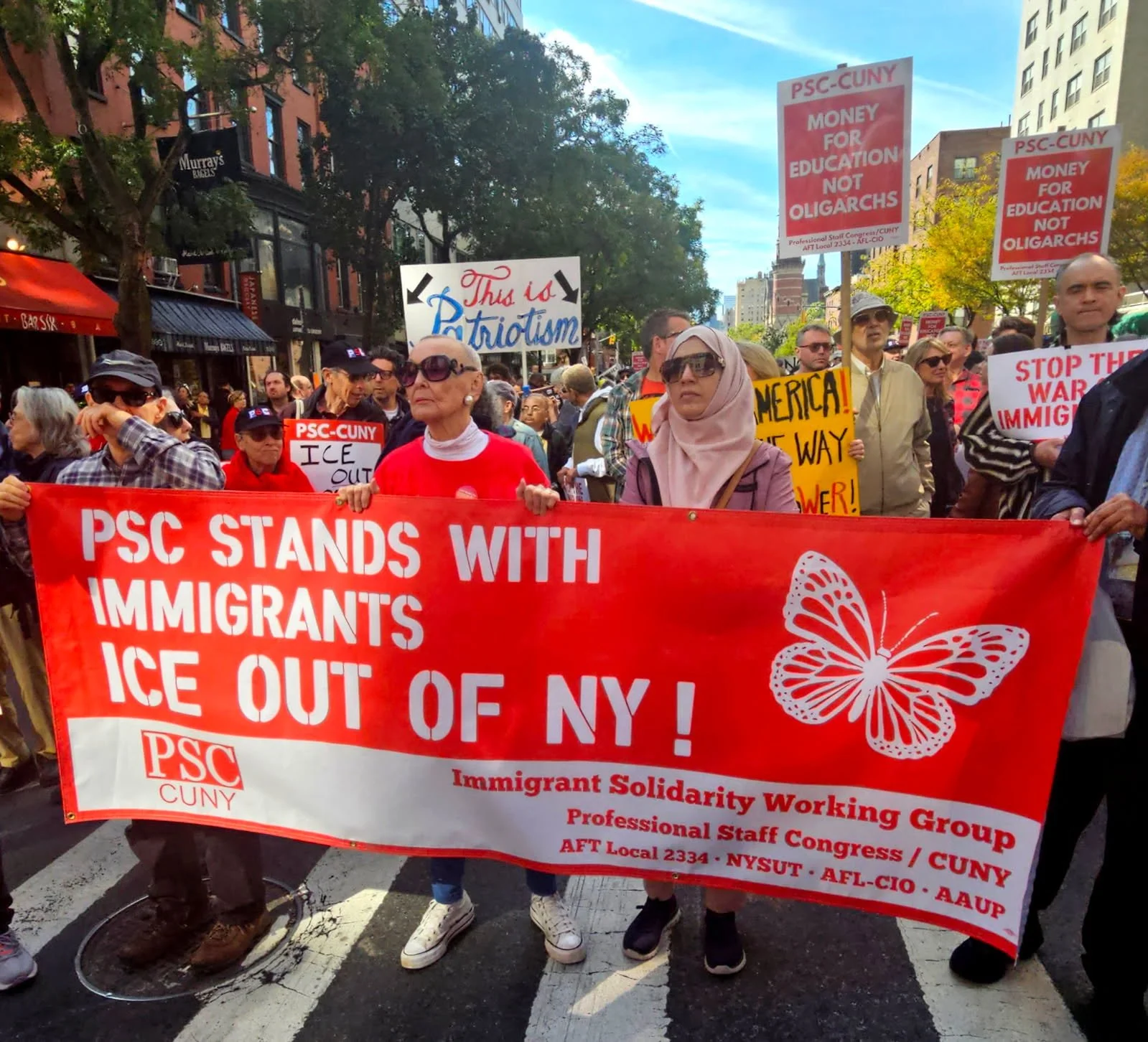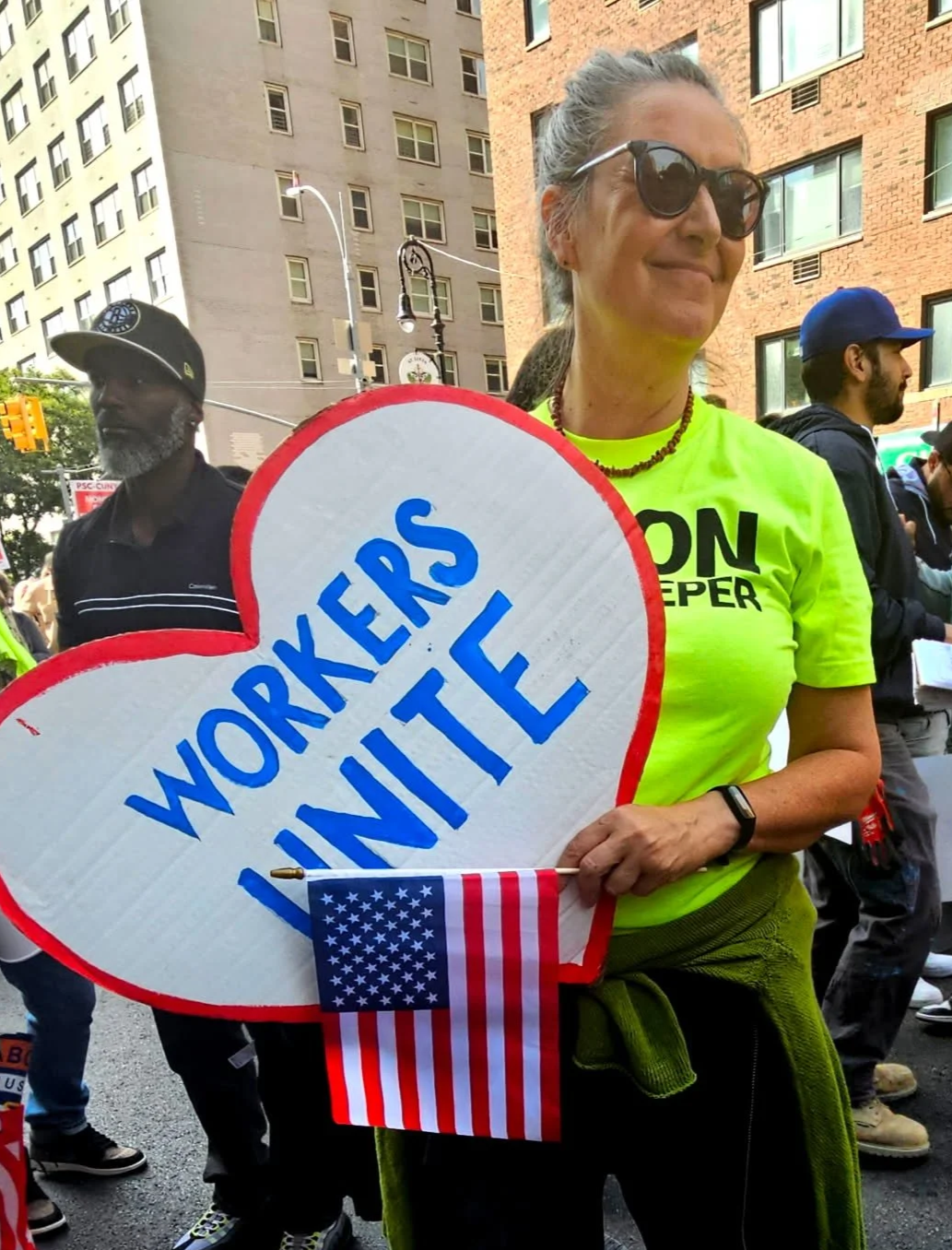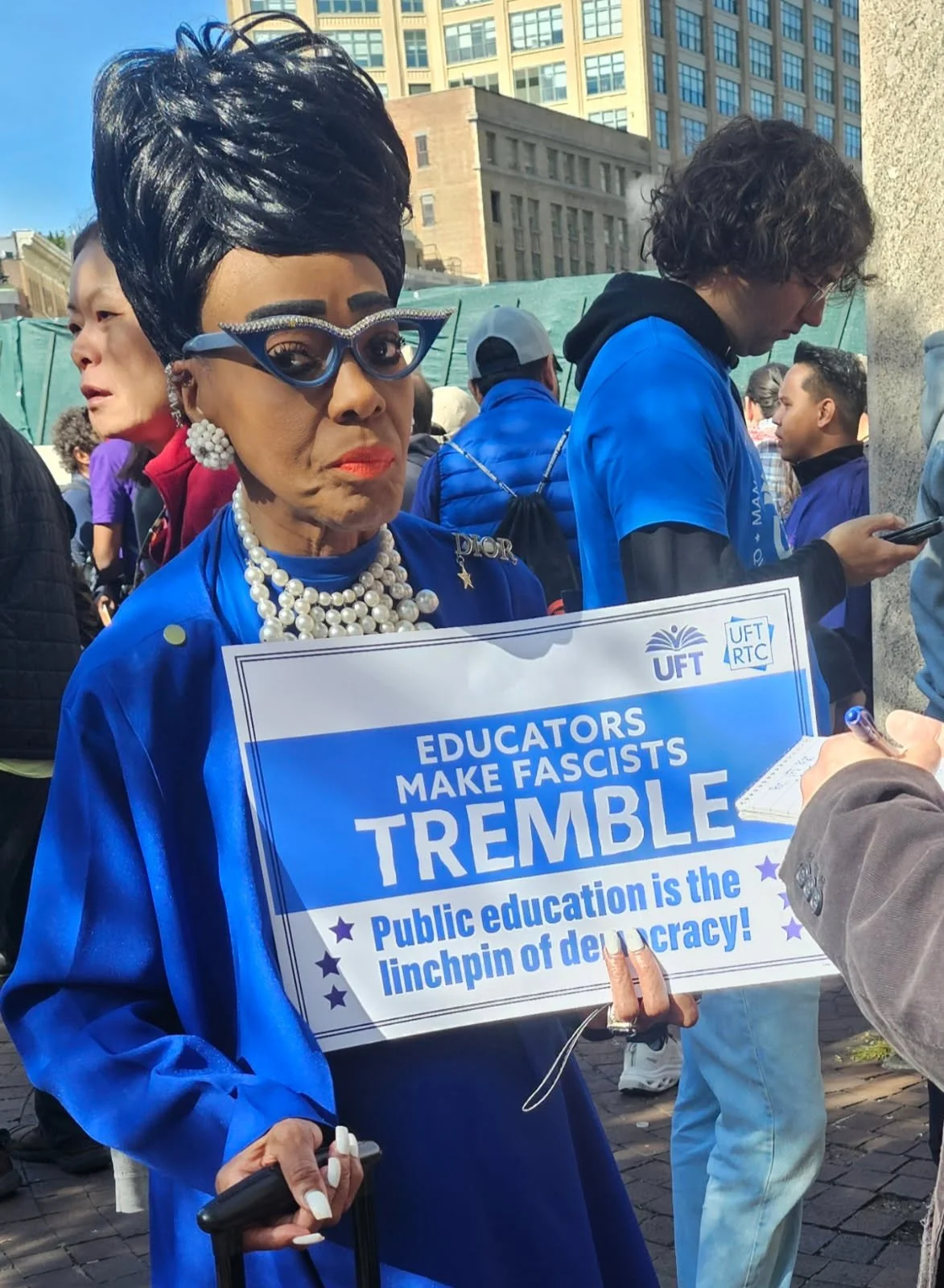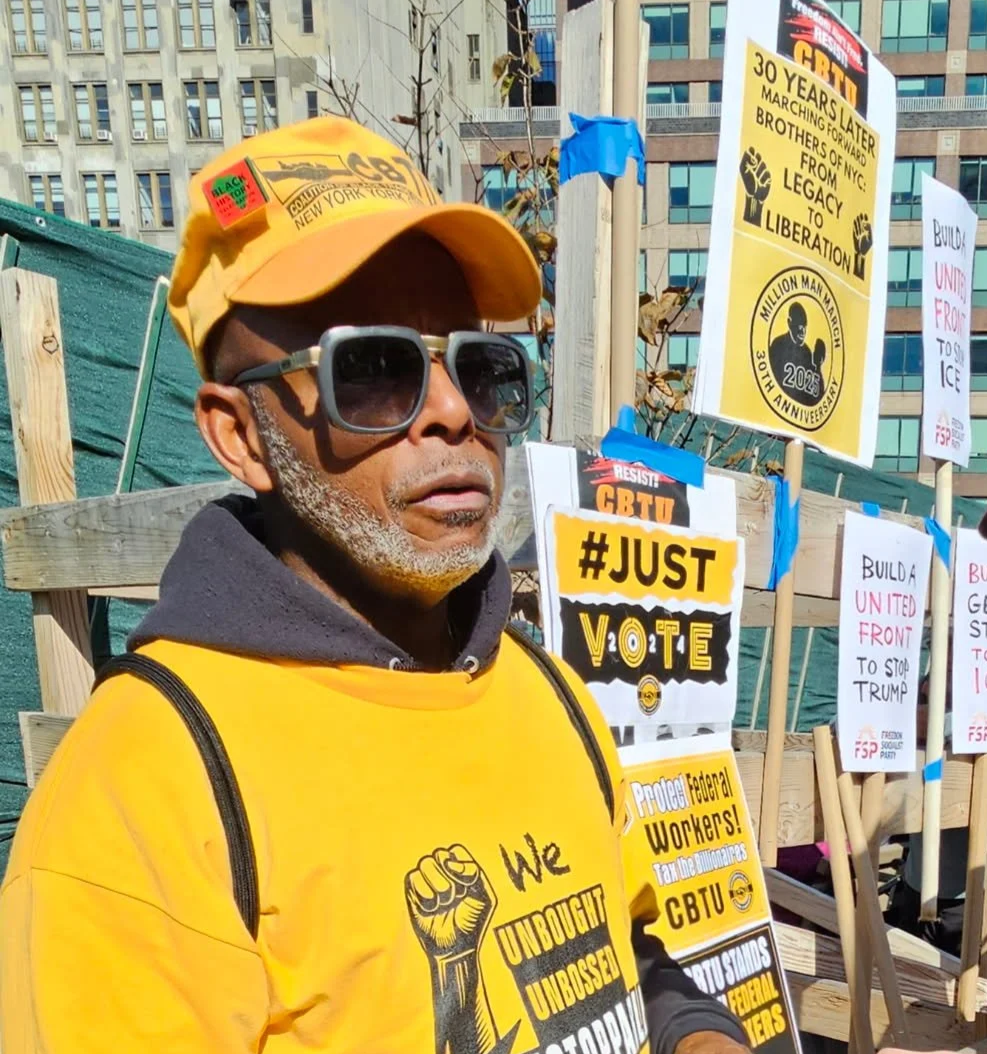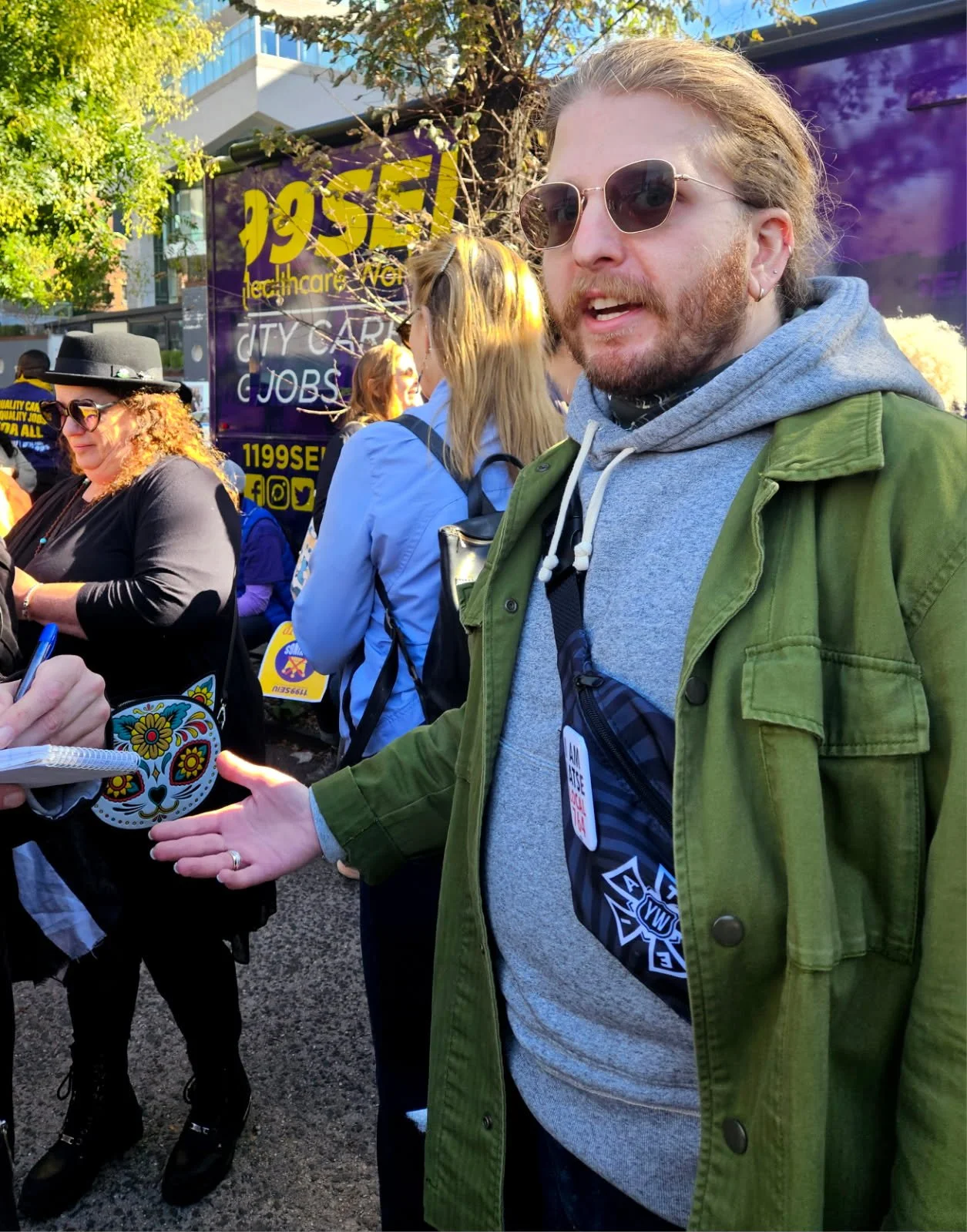NYC Unions March On ‘No Kings Day’
“It’s pretty simple,” New York City Central Labor Council President Brendan Griffith told Work-Bites. “The attacks from the federal government are attacks on all workers. We need to stand together to push back.” Photos/Judith Sokoloff.
By Steve Wishnia
“What’s at stake here is our democracy,” Charles Jenkins, president of the New York chapter of the Coalition of Black Trade Unionists, told Work-Bites as thousands of people assembled by Canal Street on the cool, sunny morning of Oct. 18.
“This nation was invented by we the people, for the people, and our government needs to abide by the doctrine of this nation and the blood that we shed for the right to vote,” Jenkins said.
The people assembling—health-care workers, teachers, nurses, construction laborers, college professors, building custodians, stagehands, and more—were preparing to march up Sixth Avenue as a union-led feeder intended to join the main No Kings march at 14th Street.
“It’s necessary. We must. We are the people,” said Diane, a National Writers Union member carrying a “Sindicato Nacional de Escritores” sign.
For the 1199SEIU members clustered near the union’s purple truck, one big motive was the Trump regime’s budget, which the union says “rips health care away” from 22 million people as it slashes more than $1 trillion from current and future federal health-care funding, particularly Medicaid, Obamacare, and likely Medicare.
Workers Unite—it’s the American way: Laborers Local 79 Organizing Director Oona Adams.
Those cuts “are closing nursing homes,” said Marilyn Roberts, rehab technician for 30 years. “We’ve all invested our years in nursing-home work.”
“It’s pretty simple,” New York City Central Labor Council President Brendan Griffith told Work-Bites. “The attacks from the federal government are attacks on all workers. We need to stand together to push back.”
Retired United Federation of Teachers member Anita Adams cut a striking figure, bearing an “Educators Make Fascists Tremble” sign and wearing a brilliant blue dress, orange lipstick, and multiple strings of pearls. She said she was protesting for “better housing, living wages, more affordable housing.”
“They’re trying to bust unions,” she added. “They can easily get rid of you if there’s no union.”
Jeffrey Colton, 32, a member of the Theatrical Wardrobe Union, IATSE Local 764, said that as a union member, he wanted to fight to get politicians to “stop cozying up to the 1%.”
“I live out in Jersey because I can’t afford to live here,” he added.
Educators Make Fascists Tremble: Anita Adams tells it like it is during NYC’s “No Kings Day” rally.
“If we don’t defend it, democracy may end,” said a 60-year-old PSC member with a South Asian accent who preferred not to give his name. “The younger people should show up more, because it’s their future. We should all do something.”
With more than 10,000 people, the march stretched for blocks as it headed north. It was significantly more diverse than previous No Kings marches in New York, which drew predominantly white people and Jewish people old enough to have voted in 2000 (the first time in modern U.S. history that Republicans tried to steal an election, with the Supreme Court stopping a recount in the decisive state of Florida).
The Professional Staff Congress contingent chanted, “ICE Out of New York.” One woman carried a shoulder bag with a reproduction of the federal government’s World War II “Instructions to All Persons of Japanese Ancestry”—its order to report to be shipped to detention camps—with a “UFT for Zohran” button pinned on the strap.
The labor march, however, arrived at 14th Street before the main march came down from Times Square, so they did not link up before turning east to go to Union Square. With no collective concluding rally scheduled, both groups had largely dispersed by the time their demonstrators reached Union Square. The PSC contingent held a brief rally there, before being succeeded by a couple small leftist sects.
What’s next?
Demonstrators asked by Work-Bites what people in the movement can do to stop the clear and present danger of fascism generally answered “protest” and “vote.”
“Voting is how you defend our democracy,” Charles Jenkins said. “In 2024, the working class was not galvanized to vote their interests and protect democracy against Project 2025.” The job now, he continued, is to “take our mobilization from the streets to the voting booth. We are the majority in this nation, and they fear us.”
Charles Jenkins talks to Work-Bites during this weekend’s “No Kings Day” demonstration in New York City.
American workers, Brendan Griffith said, should push back “at the ballot box, on the streets, in their communities, and through their unions,” and say collectively that “this country was built by working people, and our government needs to work for working people.”
Unions should do “exactly what the labor movement has been doing for years,” said Oona Adams, organizing director of Laborers Local 79, which, along with the painters’ District Council 9, has been among the few building-trades unions to participate in anti-Trump protests. That means getting in the streets and organizing, to “create a fabric that can’t be torn.”
“March, come out to support, get involved in your communities,” added Anita Adams.
Lin, a high-school teacher and United Auto Workers Local 2110 member, suggested “take care of each other” and “teach children to think critically.”
Diane, the National Writers Union member, says the current situation will be “a learning process for Americans,” who take their rights for granted.
IATSE member Jeffrey Colton talks about the possibility of having a general strike.
More direct action?
Yet large protests are generally more symbolic and inspirational than directly disruptive, and the next congressional election is not until November 2026. That’s a long wait to stop a regime whose scheisskrieg—occasional Trump adviser Steve Bannon’s fecal-blitzkrieg strategy for his second term—has already blasted the democratic process and the rule of law, as well as cancer-research funding, wind-power projects, and protections against racial discrimination. A significant number of people have suggested a general strike, but the logistics of organizing one are daunting.
“Strikes are very effective,” said Jeffrey Colton, but he worries that “with the current political climate, we don’t know what the government will do. They know when we are together, we’re more powerful than they are.”
The main people at the march calling for a general strike were the small leftist sects. The UAW and several other unions have lined up their contracts to expire in May 2028, to set up the conditions for a massive, non-wildcat walkout viable under current labor law—but that’s even further in the future.
“Every single one of us holds the line,” a Laborers Local 79 member called out on a bullhorn as the march neared 14th Street. “Right now, it’s more important than ever.”
He urged his members to bring someone new next time. “Everyone should see themselves as an organizer.”
That, he added, is how the Laborers organized the city’s demolition workers in the 1990s.

